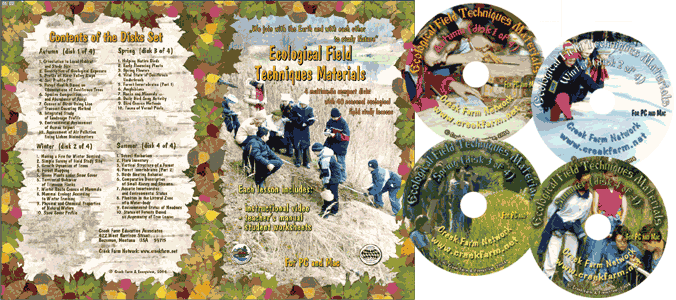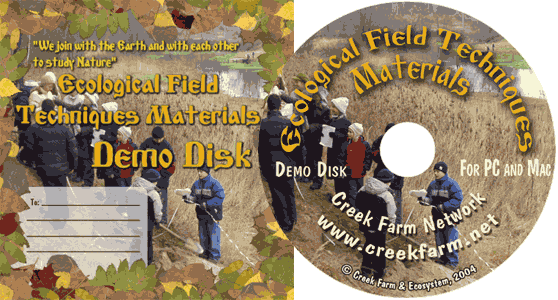|
| Our Field Ecology Center published more than
180 methodical materials for nature studies. Some of them are in English: |
|
|
|
Study of Species Composition and Number of Fungi
© Alexsander S. Bogolyubov,
Russia, 2001
© Michael J. Brody, USA,
2003
 This manual contains a procedure for the route
census of fungi, fields study design and laboratory processing of collected samples,
including determination of species, estimation of fungi stock as well as classification of
fungi according to edibility and toxicity. Students collect of fungi, census populations
and describe habitats. This manual contains a procedure for the route
census of fungi, fields study design and laboratory processing of collected samples,
including determination of species, estimation of fungi stock as well as classification of
fungi according to edibility and toxicity. Students collect of fungi, census populations
and describe habitats.
This field study has instructional video
featuring real students conducting the ecological field techniques in nature. Each video
illustrates the primary instructional outcomes and the major steps in accomplishing the
task including reporting the results.
Introduction
Fungi belong to a large group of living organisms (about 65,000 species), which is
defined as a separate kingdom, Fungi: (Mycota, Mycetalia). They are characterized
by both plant features (immobility, unlimited growth, ability to synthesize vitamins, cell
walls, and feeding through absorption of food) and animal features (presence of chitin in
cell walls and urea in metabolism, storage of carbohydrates in the form of glycogen, but
not starch; absence of starch and heterotrophic nutrition, i.e. obtaining carbon from
organic substances produced by other organisms is necessary for development and growth).
The kingdom Fungi consists of two divisions: Slime fungi or Myxomycetes
(Myxomycota) and True fungi (Eumycota).
True fungi include eight classes; according to structure of spawn (mycelium), they are
divided into microscopic fungi, in which the mycelium consists of one (sometimes very
long, up to several dozens of centimeters) multinuclear cell, and higher fungi with
multicellular mycelium. At this lesson we will focus on studies of higher fungi.
Most fungi are microscopic organisms that are not seen with the naked eye. Such fungi
are called Micromycetes. Results of their functioning include the destruction of
various materials, spoiling of food products, various molds and mildews. Other fungi,
which are not so numerous, form noticeable fruiting bodies; such fungi are called Macromycetes.
They will be discussed below.
Let us briefly list some peculiar features of fungus structure and growth before
describing a research procedure for fungi. The spawn of higher fungi, which grows and
performs functions of nutrition, respiration and reproduction, is called mycelium.
It is a dense interlacement of thin ramified threads (hyphae), which are
about 5-10 microns thick. Mycelium grows radially in all directions with a rate of about
10-50 cm a year. The lifespan of a spawn of higher fungi reaches 10-25 years and even more
(up to several hundred years). Mycelium grows from spores or separate pieces of mycelium,
which fall into favorable conditions in soil at the depth of about 5-15 cm or on other
substratum, for instance, on wood.
A dense interlacement of hyphae forms fruiting bodies, that we call
mushrooms. The fruiting body is a reproductive organ, which stands out above the
substratum surface. Its functions include development, protection and dispersal of spores.
Fruiting bodies are formed on the ends of actively growing spawns in groups, so when the
central part of the spawn dies off, some species of fungi form well-visible rings of
fruiting bodies Ц so-called Уfairy rings," which can be from three up to 50
meters in diameter.
Procedure of collection and census of fungi
Macromycetes, higher fungi, which form fruiting bodies and are found in forest
litter and on wood, will serve as objects for study in this lesson. The amount of
their representation in the area of study, as well as the availability of Уlabor
resourcesФ will determine whether to study one group of fungi or both of them. If ground
forms of fungi dominate in your area and the size of the studentsТ group is not large
(up to 10 pupils), it is possible to restrict the study to research of the mentioned
fungi, with the exception of wood fungi. If there are many wood-attacking fungi in the
forest and many studentsТ groups are available, then some of the research can be devoted
to the study of wood-attacking fungi.
In any case, the research team will have the following tasks: 1) to compile a
list of fungus species found in your area that is as complete as possible; 2) to determine
population density of different fungus species in different biotopes; 3) to identify
environmental conditions typical for the most abundant or most valuable (for example, from
a food point of view) fungus species. Material for completion of the mentioned tasks is
collected simultaneously in the course of fieldwork.
The time needed for these investigations depends on specific conditions of the area
of study. The maximum development of higher macromycetes in the Central part of Russia
occurs in September; however, it is quite possible to carry out the research in...
This was only the first page from the manual and its full version you can see in the
Ecological Field Studies Techniques Video 4CD Set:
It is possible to purchase the complete set of 40 seasonal Ecological Field
Studies Techniques Video (in mpg format) in an attractive 4 compact disk set.
These compact disks are compatible with Mac and PC computers.
The videos are suitable for individual student or whole class instruction. To purchase the complete 4CD set
write to ecosystema1994@yandex.ru in a free form.

Ecological Field Studies Demo Disk:
We also have a free and interesting demonstration disk that explains our ecological field studies approach.
The demo disk has short excerpts from all the seasonal field study videos as well as sample text from all the teacher manuals.
The disk has an entertaining automatic walk through which describes the field study approach and explains how field studies meet education standards.
You can also download the Demo Disc from ecosystema.ru/eng/eftm/CD_Demo.iso.
This is a virtual hybrid (for PC and Mac computers) CD-ROM image (one 563 Mb file "CD_Demo.iso").
You can write this image to the CD and use it in your computer in ordinary way.
You also can use emulator software of virtual CD-ROM drive to play the disk directly from your hard disk.

|







